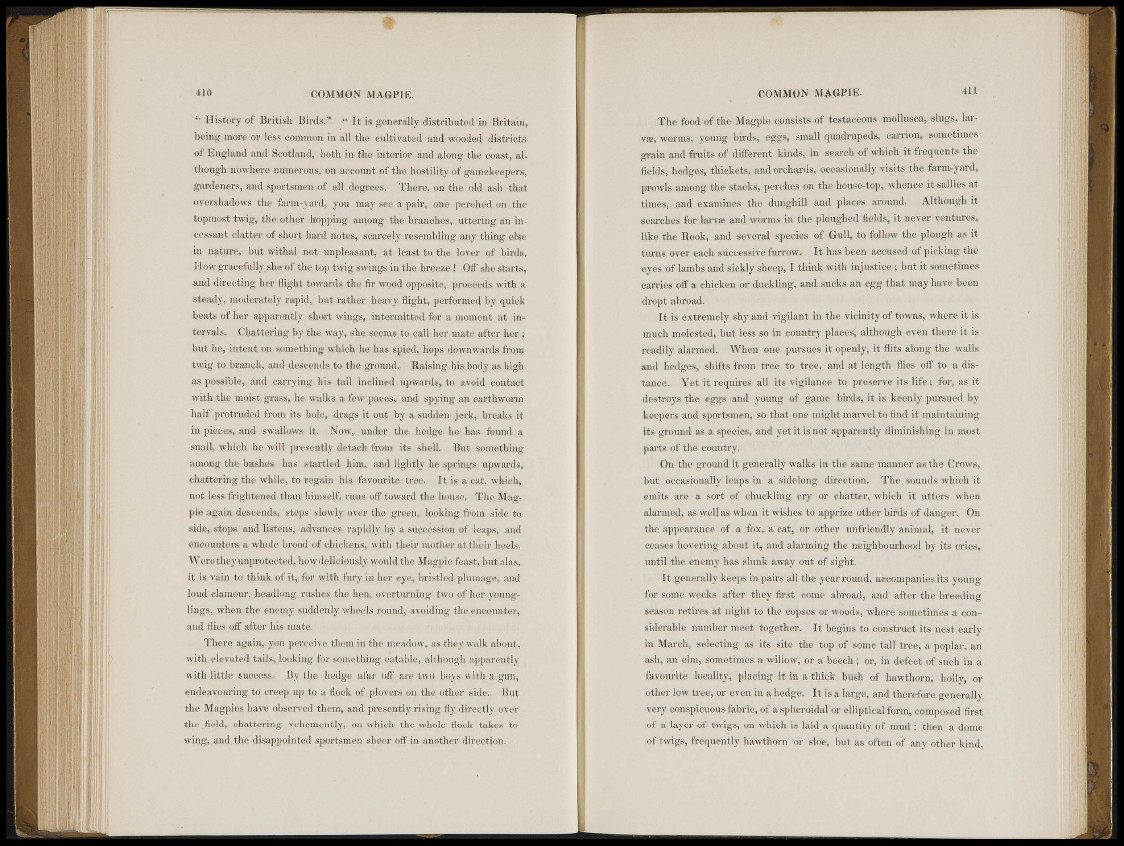
410 COMMON MAttPIK.
History of British Birds.? « Itii-generally distributed in Britain,
being m»re or loss common in all the cultivated and wooded! districts
of England and j Spotland, both in the interior and along the ¡coast, although
nowhere munorcms, on account of the hostility of gamekeepers,
gardeners, tod sportsmen of.%11 degrees. There, on the old ash that
overshadows the farm-yard, you may see a pair, one perched on the
topmost tvviff, th© other hopping among the branches, lettering an incessant,
(flatter of short hard notes, scarcely resembling any thing «ftfe
in nature, bat withal not unpleasant, at least 1» tlu- Joyer nt' wirds.
How gracefully slio of thi! top twig swings; in the breeze ! Off she starts,
and directing- her flight towards thgifir wood opposite,, proceeds with a
steady, moderately rapid, but rather heavy flight, performed by quick
heats of her apparently; sho*t wings, intermitted for % moment. at intervals.
Chattering by the. way,.she seems: to cull her mate after her ;
but he, ¡inert on something which ho bus spied, hups downwards from
twig, to branch, and descends to the ground.. Raising hist body as high
as possible,, and carrying, his- tail inclined upwards* avoid ciintiict
with the rjtoisK jvijass, ho walks a few paces, and spying a-a. earthworm
half prot ruded from its hole, drags it, out. by a sudden jerfc,, breaks it,
in pieces, ami swsSows it. Now;,, under- the hedge- hei has- found- a
snail, which he will presently detJie.h from. its shp.lL Hut something
among the. bashes has startled, him, and lightly he springs upwards,
chattering the while, to regain his favourite tree. It is a. cat, which,
not frio-htene-d- thiwji himself. runs- oil' tow^u-ii the house*- Th'u Magpie
again descends, stops; slowly over the green,, looking-from, side to
side,, stops and listens, ad.vaneo.sj rapirily liy a. succession of leaps, and
encounters, a. whole brood of chickens, with their mother at their heels,
^gfie-theyunprotected,, how deliriously would the Magpie feast, butalas,
it, is vain to think, of it, for with i'urv in her eye,,bristled,plumage,, and
loudi clamour, headlong, rushes the,hen,,overturning' two, of her younglings.
whori the enemy suddenly wheels round, avoiding the encounter,
and flies off after lii.s. mate.
There again, yuu perceive them in the meadow, its th*:y, wal* about,
with elevated tails, looking for something eatable, although apparently
with little success. By the hedge afar tiff are two boys with.a gun,
endeavouring, to creep up to a flock- of plovers on the other side. But
the. Magpies have observed them, and presently rising fly directly over
the field, chattering vehemently, on which the whole flock takes to
wing, and, the disappointed sportsmen-sb^er off in another direction.
COMMON MAGPIE. 411
The food of the Magpie consists of testaceous mollusoa, slugs, lar-
TO, w o r m young birds, eggs, small quadrupeds, carrion, sometimes
grain and fruits of different, kinds, in search of which it frequents the
fields, hedges, thickets, and orchards, occasionally visits the farm-yard,
prowls among: the stacks, perchés on the house-top, whence, it sallies at
times,- and examines the dunghill and places around. Although it
searches for larvce and worms in the ploughed fields, it never ventures,
like the Rook, and several species, of Gull, to fellow thé. plough as it
turns over each successive furrow. It has been accused of picking the
eyes of lambs and sickly sheep, I think with injustice:; but it sometimes
carries off a chicken or duckling, and sucks an egg that may have been
dropt abroad.
I t is extremely Shy and vigilant in the vicinity of towns, where it is
much molested, but loss so in country places, although even there it is
readily alarmed. When one pursues it openly, it flits along the walls
and .Hedges, shifts from trie to tree, and at length flies off to a distance.
Yet it requires all its vigilance to preserve its life; for, as it
destroys thé eggs and young of game birds, it is keenly pursued by
keepers, and sportsmen, so that one might marvel to find it maintaining
its ground as a species, and yet it is not apparently diminishing in most
parts of the country.
On the ground it generally walks in the same manner as the Crows,
but occasionally leaps in a sidelong direction. The sounds which it
emits are a sort of' chuckling cry or chatter, which it utters when
alarmed, as wol 1 as when it wishes to apprize other birds of danger. On
the appearance of a fox, a cat, or other unfriendly animal, it never
ceases hovering about it, and alarming the neighbourhood by its cries,
until the enemy has slunk away out of'sight.
It generally keeps in pairs all the year round, accompanies its young
for some weeks after they first come abroad, and" after the breeding
season retires at night to the copses or woods, where sometimes a considerable
number meet together. It begins to construct its nest early
in March, selecting as its site the top of some tall' tree, a poplar, an
ash, an elm, sometimes a willow, or a beech ; or, in defect of such in a
favourite locality, placing it in a thick bush of' hawthorn, holly, or
other low tree, or even in a hedge. It is a large, and therefore generally
very conspicuous fabric, of a spheroidal or elliptical form, composed first
of a layer of* twigs, on which is laid' a quantity of mud ; then a dome
of twigs, frequently hawthorn or slOe, but as often of any other kind,